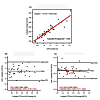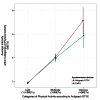Comparison of physical activity measures using mobile phone-based CalFit and Actigraph
- PMID: 23896156
- PMCID: PMC3713904
- DOI: 10.2196/jmir.2470
Comparison of physical activity measures using mobile phone-based CalFit and Actigraph
Abstract
Background: Epidemiological studies on physical activity often lack inexpensive, objective, valid, and reproducible tools for measuring physical activity levels of participants. Novel sensing technologies built into smartphones offer the potential to fill this gap.
Objective: We sought to validate estimates of physical activity and determine the usability for large population-based studies of the smartphone-based CalFit software.
Methods: A sample of 36 participants from Barcelona, Spain, wore a smartphone with CalFit software and an Actigraph GT3X accelerometer for 5 days. The ease of use (usability) and physical activity measures from both devices were compared, including vertical axis counts (VT) and duration and energy expenditure predictions for light, moderate, and vigorous intensity from Freedson's algorithm. Statistical analyses included (1) Kruskal-Wallis rank sum test for usability measures, (2) Spearman correlation and linear regression for VT counts, (3) concordance correlation coefficient (CCC), and (4) Bland-Altman plots for duration and energy expenditure measures.
Results: Approximately 64% (23/36) of participants were women. Mean age was 31 years (SD 8) and mean body mass index was 22 kg/m(2) (SD 2). In total, 25/36 (69%) participants recorded at least 3 days with at least 10 recorded hours of physical activity using CalFit. The linear association and correlations for VT counts were high (adjusted R(2)=0.85; correlation coefficient .932, 95% CI 0.931-0.933). CCCs showed high agreement for duration and energy expenditure measures (from 0.83 to 0.91).
Conclusions: The CalFit system had lower usability than the Actigraph GT3X because the application lacked a means to turn itself on each time the smartphone was powered on. The CalFit system may provide valid estimates to quantify and classify physical activity. CalFit may prove to be more cost-effective and easily deployed for large-scale population health studies than other specialized instruments because cell phones are already carried by many people.
Keywords: accelerometry; cellular phone; global positioning systems; monitoring; motor activity; physiologic.
Conflict of interest statement
Conflicts of Interest: None declared.
Figures





References
-
- Lee IM, Shiroma EJ, Lobelo F, Puska P, Blair SN, Katzmarzyk PT, Lancet Physical Activity Series Working Group Effect of physical inactivity on major non-communicable diseases worldwide: an analysis of burden of disease and life expectancy. Lancet. 2012 Jul 21;380(9838):219–29. doi: 10.1016/S0140-6736(12)61031-9. - DOI - PMC - PubMed
-
- World Health Organization . Global Health Risks: Mortality and Burden of Disease Attributable to Selected Major Risks. Switzerland: World Health Organization; 2009. [2013-05-16]. 6GfHnj9nS http://www.who.int/healthinfo/global_burden_disease/GlobalHealthRisks_re....
-
- Department of Health, Physical Activity, Health Improvement and Prevention. 2004. [2012-12-02]. At least five a week: Evidence on the impact of physical activity and its relationship to health http://www.dh.gov.uk/en/Publicationsandstatistics/Publications/Publicati....
-
- Prince SA, Adamo KB, Hamel ME, Hardt J, Gorber SC, Tremblay M. A comparison of direct versus self-report measures for assessing physical activity in adults: a systematic review. Int J Behav Nutr Phys Act. 2008;5:56. doi: 10.1186/1479-5868-5-56. http://www.ijbnpa.org/content/5//56 - DOI - PMC - PubMed
-
- Belton S, O'Brien W, Wickel EE, Issartel J. Patterns of non-compliance in adolescent field based accelerometer research. J Phys Act Health. 2012 Nov 30;:1–10. (forthcoming) - PubMed
Publication types
MeSH terms
Grants and funding
LinkOut - more resources
Full Text Sources
Other Literature Sources
Miscellaneous

